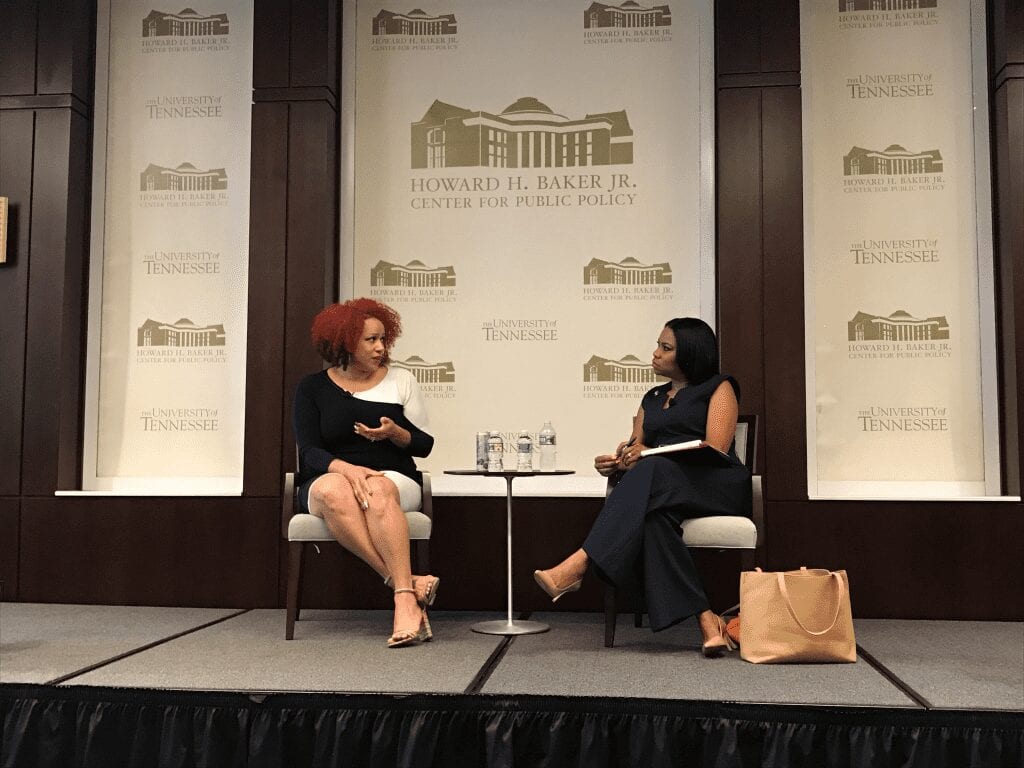Investigative journalist explains modern segregation
New York Times reporter Nikole Hannah-Jones visited the University of Tennessee to discuss modern implications of racial divide.

As the nation stands divided because of Nike’s recent ad featuring embattled quarterback Colin Kaepernick, many questions of racial equality persist. During the 2016 NFL season, Kaepernick knelt during the national anthem in social protest against oppression of people of color. From citizens to the president, America remains divided.
New York Times Magazine investigative reporter Nikole Hannah-Jones discussed realities of segregation in modern day America at the University of Tennessee Howard Baker Center Thursday, Sept. 6. WATE’s Good Morning Tennessee co-anchor Tearsa Smith moderated the event.
Hannah-Jones started her journalism career with the intentions to help marginalized communities to “narrate their own stories.” She hoped to create more opportunities in the journalism industry. After many years as a beat reporter, she transitioned to such investigative journalism five years ago. She researches public housing, neighborhood planning, school systems and zoning, poverty and distribution of resources.
“My work is excavating very clearly where [modern segregation] comes from,” Hannah-Jones said. “It comes from a legacy of racial caste in this country, it comes from two centuries of force and codified racial segregation.”
She particularly emphasized segregation in schools, as early education provides the basis for American life. School zone planning can be a root of segregation. Zoning sometimes clumps poor people of color together, systematically separating them from everyone else. Hannah-Jones’ research also shows impoverished schools with large minority populations lack the resources of predominantly white schools. Such schools struggle to secure certified board teachers, advanced placement classes, textbooks and science labs.
Attendee and junior Cheyenne Aune said, “lack of resources in segregated, high-poverty schools is basically setting people of color up for failure.”
Hannah-Jones extended the discussion by elaborating on segregation issues in predominately white communities. If students are not exposed to differing races and cultures, problems persist.
In an attempt to resolve the divide, Hannah-Jones co-founded the Ida B. Wells Society. The society trains investigative journalists of color to start their careers in a field dominated by white reporters. Free membership and low cost workshops allow reporters to improve their skills in obtaining sources and documents, handling data and coding.
The namesake of Hannah-Jones’ work reflects and inspires her mission. Ida B. Wells reported on social injustices and prejudices in the late 19th and early 20th centuries. Investigating lynching in America, Wells published editorials in her own paper, the Memphis Free Speech. Though white men destroyed her office and threatened her life, Wells pressed on, advocating for urban reforms, suffrage and equity under the law.
School of Journalism & Electronic Media professor Amber Roessner recently published a co-edited volume detailing Wells’ political impact. Roessner also hosted the Ida B. Wells & Beyond Conference as a part of the Ida Initiative in 2015 with students and scholars from around the country.
“As a nation, we must all make a commitment to social justice to foster equity in education and other areas of life, but many folks are unwilling to make that commitment,” Roessner said. “Some, blinded by bigotry and greed, instead are intent on upholding an inequitable, unjust system.”
Roessner and University of Tennessee journalism history students continue to study Wells’ legacy as a “Pioneer of the Political Press.”
As for Hannah-Jones, she will continue her modern crusade against segregation.
Story by Vanessa Rodriguez and Ciera Noe
Featured Image by Vanessa Rodriguez
Edited By Lexie Little

